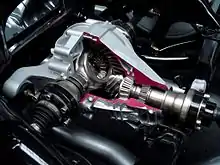Powertrain
In a motor vehicle, the powertrain comprises the main components that generate power and deliver that power to the road surface, water, or air. This includes the engine, transmission, drive shafts, differentials, and the final drive (drive wheels, continuous track as in military tanks or caterpillar tractors, propeller, etc.). Hybrid powertrains also include one or more electric traction motors that operate to drive the vehicle wheels. All-electric vehicles ("electric cars") eliminate the engine altogether, relying solely on electric motors for propulsion. Occasionally the term powerplant is casually used to refer to the engine or, less often, the entire powertrain.
.jpg.webp)
A motor vehicle's driveline or drivetrain consists of the parts of the powertrain excluding the engine. It is the portion of a vehicle, after the prime mover, that changes depending on whether a vehicle is front-wheel, rear-wheel, or four-wheel drive, or less-common six-wheel or eight-wheel drive.
In a wider sense, the powertrain includes all of the components used to transform stored (chemical, solar, nuclear, kinetic, potential, etc.) energy into kinetic energy for propulsion purposes. This includes the utilization of multiple power-sources and non–wheel-based vehicles.
Developments
The most recent developments in powertrain are driven by the electrification of it in multiple components. Electrical energy needs to be provided, usually this leads to larger batteries. Electric motors can be found as isolated component or as part of other elements, e.g. the axle. In hybrid powertrains the torque generated by the combustion engine and the electric motor have to be brought together and distributed to the wheels. The control of this process can be quite involved but the rewards are greatly improved acceleration and much lower emissions.
Powertrain development for diesel engines involves the following: exhaust gas recirculation (EGR), and advanced combustion. Spark ignition engine development include: fuel injection, including the gasoline direct injection variant, as well as improving volumetric efficiency by using multi-valves per cylinder, variable valve timing, variable length intake manifolds, and turbocharging. Changes also include new fuel qualities (no sulphur or aromates) to allow new combustion concepts. So-called "combined combustion systems" (CCV) or "diesotto" cycles are based on synthetic fuels (synthetic diesel, biomass to liquid (BTL) or gas to liquid (GTL)).[1]
BEVs, FCEVs and PHEV powertrains are expected to reach cost parity with ICE powertrains in 2025.[2]
Manufacturing
The manufacturing of powertrain components and systems is important to industry, including the automotive and other vehicle sectors. Competitiveness drives companies to engineer and produce powertrain systems that over time are more economical to manufacture, higher in product quality and reliability, higher in performance, more fuel efficient, less polluting, and longer in life expectancy. In turn these requirements have led to designs involving higher internal pressures, greater instantaneous forces, and increased complexity of design and mechanical operation. The resulting designs in turn impose significantly more severe requirements on parts shape and dimension; and material surface flatness, waviness, roughness, and porosity. Quality control over these parameters is achieved through metrology technology applied to all of the steps in powertrain manufacturing processes.
Frames and powertrains
In automotive manufacturing, the frame plus the "running gear" makes the chassis.
Later, a body (sometimes referred to as "coachwork"), which is usually not necessary for integrity of the structure, is built on the chassis to complete the vehicle. Commercial vehicle manufacturers may have "chassis only" and "cowl and chassis" versions that can be outfitted with specialized bodies. These include buses, motor homes, fire engines, ambulances, etc.
The frame plus the body makes a glider (a vehicle without a powertrain).
Final drive

The final drive is the last in the set of components which delivers torque to the drive wheels. In a road vehicle, it incorporates the differential. In a railway vehicle, it sometimes incorporates the reversing gear. Examples include the Self-Changing Gears RF 28 (used in many first-generation diesel multiple units of British Railways)[3] and RF 11 used in the British Rail Class 03 and British Rail Class 04 diesel shunting locomotives.
See also
References
- Mercedes plans petrol/diesel hybrid
- McKinsey & Company - A portfolio of power-trains for Europe
- Mann, R. H., Diesel Rail-Cars, Draughtsmens and Allied Technicians Association, 1964, pp 45–50